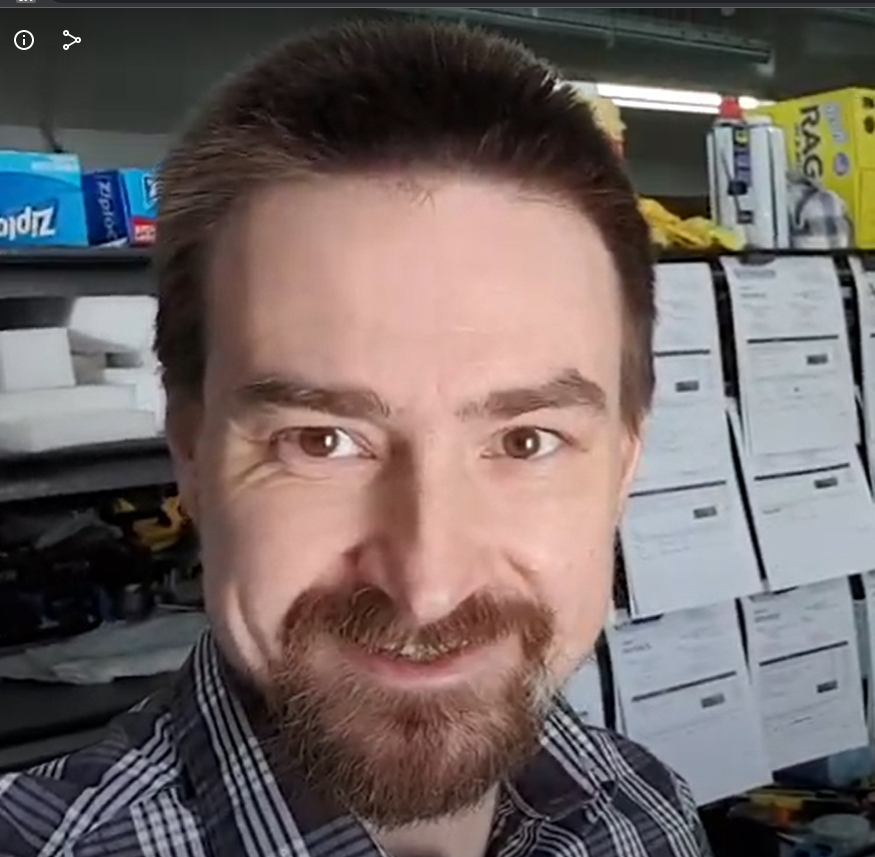Artificial stem cells seem like the next thing to really revolutionize medicine.
Quantum computers for brute force hacks seems doable in 100.
Eye tracking pointer devices will likely be more convenient than mice within a dozen or two years. This will probably be widely available for people who are paralyzed first.
Diamond processors are always 10 years away, but I think we can do it in 100. This would revolutionize the amount of power we can put through a chip without worrying about cooling.
Quick charge capacitor replacements for standard rechargble batteries
Low yield fusion plants. I’d like to think of them as capable of high yield, but it’s much harder than initially thought. Some ideas are quite promising for low yield.
The eye tracking stuff exists already. There are medical device companies that build and sell these things.
Vaccines. Maybe in 100 years we’ll even be able to eliminate measles…again.
Fast-refresh ePaper. I just want a laptop I can use outside, man!
Look up Daylight DC-1 might be what you are looking for
Oooohhh, thank you
I remember we could use the game boy advance SP outside. Is this screen technology used for PC?
They exist as monitors. In videos they kind of look like really early crappy LCD screens.
I’d just sit in the shade.
Tricorders, cellphones are already partway there they just need more durable, small sensors like a handheld light spectrometer to tell what things are made of and a handheld interferometer to detect gravity
Check out the app Phyphox, it uses all your existing sensors and probably surpasses tricorders in several ways while, of course, lacking in a few others.
I can detect gravity without a device:
Jump off a roof. If you hit the ground, you’ve detected gravity.
You could just raise your arm and let it loose…
Computer circuits based on light instead of electricity.
We currently carry tricorders in our pockets. I can see a medical tricorder being ubiquitous for field medics, ships, and the like within 100 years.
Is it cheating to say AI and humanoid robots?
Anti-aging tech, if so.
A lot of black mirror stuff.
Apologies for the blanket pessimism but the last decades darkened my view.
Nuclear fusion seems increasingly achievable.
They are down to 2 main problems now. The main one is (the cost of) scaling up. Fusion reactors will be more effective then bigger they are. The tiny test ones are already past break even.
The other is wall material. Apparently the radiation has an annoying ability to transmute the elements making up the wall of the reactor. They are working out a material that can maintain its bulk mechanical properties, even with random elements appearing in its internal structure.
The only one I heard news about breaking even was that thing that shot a lot of lasers to a pellet. For a fraction of a second It broke even or produced slightly more than they poured in, but it was much less of what they spent.
There’s been something else new?
I saw a talk on the subject about a year back. It was discussing tokamak reactors, from an engineer working on them. The small ones can’t sustain a break even state, but they are affected by the inverse square law to a larger degree. I believe China is about to start/has started construction on a power station sized test reactor.
The pellet sort are a different type. They have different pros and cons.
Cancer curing nanotechnology
borg nanoprobes, or replicator nanites of sg1 and sga.
Pre-progammed viruses to set in motion whatever changes you want in the body.
Ai and eeg can read brain waves generate images already kinda decent, maybe meet the robinsons memory viewer machine.
Can we get a dream recorder, please?!
I feel like wed learn everyone has cool dreams and pivot back to skill being a thing over just imaginstion and prompts lol
I think we can make an oven with a tiny fire breathing dinosaur in it.
So the Flintstones was actually about the future?!
The Flintstones and Jetsons happened at the same time on the same planet.
Portable communicators. It would be slick to have a USB c tricorder though.
…you mean phones?
Download the Phyphox app to access your phones raw sensor data. Very much like a tricorder.
You’ve just destroyed my afternoon, thanks and congratulations
Edit: installed it. very cool. It would be crazy on my watch though.
Hold up. I’m pretty sure things that already exist don’t count.
FTL communication using quantum entangled particles.
Not FTL though. Slower than light, causality preserving version? Sure.
Huh?
Exceeding FTL (and breaking causality) is basically a sci fi trope at this point with about as much credibility as psychics. To have at least some credibility you need one of: a testable hypothesis, or an unexplained phenomenon. Right now we have neither. At best, we have some equations, that work below light speed, where we can extrapolate past light speed and see how the math works. The problem is: none of these equations are testable as they all contain infinities or other asymptotic features that prevent passing light speed itself. So, if there’s no viable math to get from sublight to FTL, and there’s no unexplained phenomena, then what we’re left with is nothing.
Even quantum entanglement, which is a darling of sci fi whenever they need a plot device (hello Le Guin and the ansible), has categorically been shown to obey causality and the light speed limit in every lab test.
At some point it’s like asking for negative mass, antigravity, or other things that the math would allow. Except our universe doesn’t.
I’ve got a wormhole to sell you ;)
Obviously if we were to exceed light speed we would turn into lizards and mate with each other and have lizard babies. I thought this was common knowledge.
in scifi there seems to be several types of ftl: one is typical warp like drive of trek, and star wars, and hyperdrives which is similar to transwarp/slipstream/xindi vortex travel, which is interdimensional travel so not technically violating light speed. and the least common one is interdimensional teleportation, BSG reimanging uses this tech, although they dint bother trying to explain it with technobabble at all, because of the showrunners allergy to trek-speak. STD, and a single episode arc of tng a group of terrorists were using interdimensional transporters.
trek also had other forms of ftl, but those are very rare, and its pretty much similar to the last 2.
And every one of those are as grounded in reality as sci fi’s agelong obsession telepaths, telekinesis, or mutants with powers.
There is a class of modern sci fi authors are all coming to terms with this.
I’d recommend checking out stories like Neptune’s Brood – sci fi which takes on interstellar economics in slower than light scenarios.
Basically, physics says that nothing, not even information can actually travel faster than the speed of light. It’s a universal limit that shows up when you do the math on relativity. This concept is called “causality”.
Because of this, FTL communication is probably impossible. Quantum entanglement seems like it could provide a loophole, but it doesn’t actually work that way. To actually use quantum entanglement for communication, it actually needs a confirmation message, which would have to be delivered by a different means (every quantum message needs a non-quantum confirmation). That confirmation would be bound by the speed of light, thus preserving causality.
This is a very very rough description based on my memory, so some details may be a little off, but it should cover the gist. This article goes into more detail:
https://bigthink.com/starts-with-a-bang/quantum-entanglement-faster-than-light/
Edit: After reading, the answer is more that attempting to impart information onto the entangled particles to send a message necessarily breaks the entanglement and thus does not transmit the information to the other side. Entangling the particles makes their states related to each other, but only at the time of entanglement, and anything that changes either particle (including measuring it) will break the entanglement going forward.
Yup. You just summed up the start of the conversation I had with ChatGPT to figure out exactly what we were talking about Here and why the fact that even if we can’t directly send coherent information, if it appears that a change in particle A directly causes a change in particle B, and it appears that that causation happened Instantaneously, we can’t ever prove it or measure it or know it for certain, because the proving measuring and knowing would have to have occurred at instantaneously themselves in order to actually be proof at all. The even more fascinating part I wound up with is discovering the Holographic Principle, as discovered by Beckenstein and later expanded on and proven by Stephen Hawking, that says that all information in the 3-D world is actually encoded into a 2-D framework. That one blew my mind and I’m gonna be thinking about that for a while.
The holographic principle is fascinating, though a quick nitpick: I’m pretty sure we’ve only proven it for contracting spacetimes (as opposed to our expanding one), but a lot of people imagine it does apply to ours as well (I certainly suspect it does)
I followed this branch of the rabbit hole. Goddamn you for bringing another contradiction into play in my brain!
Not possible; entanglement collapse can’t be used to send information
The idea is this:
2 particles are quantum entangled. Whatever happens to one instantly happens to the other regardless of distance.
So you establish a state that means “0” and a state that means “1” and you can send binary.
At a minimum, you have quantum Morse code.
If you change one of the particles it just breaks the entanglement. If you measure one, then you instantly know the state the other will have when measured, but the result of your measurement - and therefore the other one also - is random. The only way to correlate the two measurements of the two particles is to send the results (at C or slower) to the same place and compare them. Otherwise each just looks like a random result.
(I know nothing about this)
Could you to the sub-C measurement test enough times to show that it just empirically works, and then use it on that basis? Or are you saying that the sub-C measurement would prove that it doesn’t work (and it produces random noise)?
I’m not sure what you mean by ‘use it on that basis’. Yes, entanglement has been proven to work, but it can’t be used to communicate FTL.
Read the link posted. They already did it. In 2007. At a distance of 144km.
I read it. Doesn’t mention FTL, because that’s not a possibility for actually transmitting info.
Edit: I think the way these quantum encryption systems work is that basically the photons (and I assume it’s polarization being measured) become the encryption key to a message that is sent conventionally.
Like the sender generates a bunch of entangled photons, sends the paired ones to the recipient, measures their photons and uses the results to encrypt the message, the receiver measures theirs and gets the same results, the sender sends the encrypted message over email or whatever, and the recipient has the same key because of entanglement.
Meanwhile an eavesdropper measuring the photons would mess them up for the recipient so the message wouldn’t decrypt.
I’m familiar with quantum entanglement. It doesn’t work because you have no way of affecting which state you’ll measure, and thus what state the other particle will be in.
Read the link posted. They already did it. In 2007. At a distance of 144km.
That wasn’t FTL
That’s not the part you were trying to say couldn’t be done. ;) You were trying to argue that quantum entanglement couldn’t be used to communicate, clearly it can.
The FTL bit is the science fiction premise of the thread. ;)
That is indeed that bit I was saying couldn’t be done. Entanglement alone can’t be used to communicate; a signal has to be sent conventionally over the distance.
The FTL bit is physically impossible, so it’s not really “achievable in a reasonable time-frame”
Exoskeletons like Ripley’s in Alien. We’ve got smaller ones, but I want to pilot a walking fork lift.
Pipe dream - battlemechs aka mechwarrior (not pacific rim). Very impractical but I want one anyway. Yes, I saw the robot fighting league by Megabots. I have their poster.
I’ve seen prototypes of these that were very impressive since like a decade ago, so I’m fully expecting those to be here soon. Power supply usually is the biggest issue











